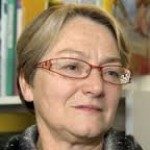Link to Pubmed [PMID] – 7138826
Biochemistry 1982 Sep;21(19):4756-61
Resonances of H alpha, H beta, and HN (amide) protons have been assigned in the NMR spectrum for ten residues in a region of beta-sheet structure of lysozyme. The assignments were achieved primarily by interpretation of nuclear Overhauser effects in conjunction with spin decoupling. The HN hydrogens involved in main-chain hydrogen bonding were found to exchange slowly with D2O solvent, although one of the most slowly exchanging HN hydrogens is not classified as being involved in a hydrogen bond in the crystal structure. Spin-spin coupling constants between H alpha protons and HN and H beta protons correlated well with values predicted from the crystal structure by means of the Karplus relationship. For no residues are the coupling constant discrepancies greater than 2.5 HZ. This indicates that for the residues studied here the torsion angles phi and chi 1 defined in the crystal structure describe accurately, generally well within 20 degrees, those for the average solution state.

